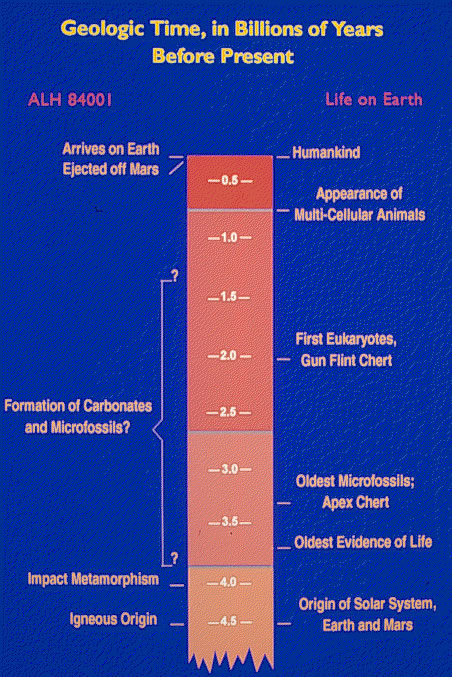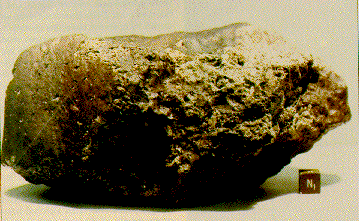|
 |
ALH84001 is one of nearly 200 meteorites discovered on Earth thought to be from Mars. There is a group of meteorites called SNCs to which ALH84001 belongs. Gas bubbles trapped in the SNCs have composition which matches the current Martian atmosphere as measured by the Viking Landers, compelling evidence that the SNCs came from Mars.
An examination of ALH84001 believed to be from Mars shows: 1) hydrocarbons which are the same as breakdown products of dead micro-organisms on Earth; 2) tiny carbonate globules which contain mineral phases consistent with by-products of bacterial activity, and tiny structures that might be microfossils of the primitive bacteria, all within a few hundred-thousandths of an inch of each other.



The indication for life hinges on three important pieces of evidence, all discovered within mineralized fractures in the meteorite in close proximity to each other.
Caveat. First, chemical analysis showed that the meteorite contained a variety of organic molecules known as polycyclic aromatic hydrocarbons or PAHs. PAHs can be produced by biological processes, and that's what McKay and his colleagues argued. But they are also commonly found in asteroids, comets and meteorites, not to mention the Antarctic ice where ALH84001 is estimated to have lain for 13,000 years. For that reason, skeptics immediately dismissed the importance of PAHs in the Martian meteorite. Caveat. A second line of evidence that the elongated blobs in the electron microscope images could be fossils of ancient Martian bacteria was also rejected by many scientists. The problem was most of the blobs were smaller than any bacteria that had ever been observed on Earth. A National Research Council panel concluded in 1998 that the blobs were 100 to 1,000 times too small to be free-living organisms because they couldn't have held all the proteins, DNA and other molecules necessary for even the simplest metabolic processes. There are, however, some features in ALH84001 that may be large enough. Other lines of evidence survived longer, ones that revolved around minerals sprinkled through the meteorite that could have been produced by microbes, magnetite and carbonate. The first mineral, carbonate , is typically formed on earth by the remains of living organisms that make shells and other skeletal parts out of minerals they extract from seawater. Some of those organisms can be quite tiny. So finding carbonate in ALH84001 could indicate the presence of ancient microbes in the rock.


The story is similar for magnetite , the other mineral of interest in ALH84001. Some bacteria produce extraordinarily small and pure magnetite crystals, then align the magnetic grains to make a microscopic compass needle that helps them navigate. The bacteria don't use their internal compasses to find north; they use them to tell up from down. Earth's spherical shape means that a compass needle in either hemisphere points at least somewhat downward, so the magnetite grains help the microbes sense where they are with respect to the planet's surface. Some of the most evolutionarily ancient bacteria on Earth produce magnetite, McKay and his colleagues pointed out. Perhaps ancient Martian microbes did as well; at least some of the magnetite grains in ALH84001 share the shape, small size and remarkable purity of those produced by bacteria on Earth. Of all the lines of evidence presented by the NASA scientists, magnetite grains are the most provocative. They were embedded in the carbonate along with other iron-containing minerals in such an unusual arrangement that something out of the ordinary must have put them there could it have been alive? |
